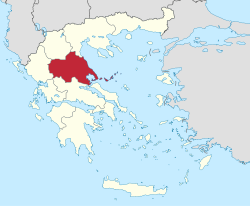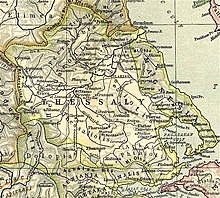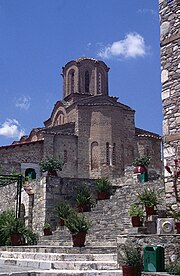Thessaly
Thessaly
Θεσσαλία (Greek) | |
|---|---|
| |
 Thessaly within Greece | |
| Coordinates: 39°36′N 22°12′E / 39.6°N 22.2°E | |
| Country | |
| Decentralized Administration | Thessaly and Central Greece |
| Cession | 1881 |
| Capital | Larissa |
| Port city | Volos |
| Regional units | |
| Government | |
| • Regional governor | UTC+3 (EEST) |
| ISO 3166 code | GR-E |
| HDI (2019) | 0.868[3] very high · 7th of 13 |
| Website | www |
Thessaly (.
Thessaly
Name and etymology
Thessaly is named after the Thessaloi, an ancient Greek tribe. The meaning of the name of this tribe is unknown, and many theories have been made about its etymology. According to the Dutch linguist Robert S. P. Beekes, the name predates Greek presence in the region and could come from the Proto-Greek form reconstructed as *Kʷʰeťťal-.[5] The Greek linguist Georgios Babiniotis also assigns the origin of the name of the Thessalians to pre-Greek times, although he does not try to explain its etymology.[6] In Aromanian it is referred to as Tesalia.[7]
Mythology
In Homer's epic, the Odyssey, the hero Odysseus visited Aeolia, the kingdom of Aeolus, which was the old name for Thessaly.[8]
The Plain of Thessaly, which lies between
According to legend, Jason and the Argonauts launched their search for the Golden Fleece from the Magnesia Peninsula.
History


Ancient history
Thessaly was home to extensive
In the summer of 480 BC, the Persians invaded Thessaly. The Greek army that guarded the Vale of Tempe was alerted by Alexander I of Macedon and evacuated the road before the enemy arrived. Not much later, Thessaly surrendered to the Persians.[10] The Thessalian family of Aleuadae joined the Persians subsequently. The following year, the Persians were decisively defeated at the Battle of Plataea and withdrew from all of their European possessions, including Thessaly.[11]
In the 4th century BC, after the Greco-Persian Wars had long ended, Jason of Pherae transformed the region into a significant military power, recalling the glory of Early Archaic times. Shortly after, Philip II of Macedon was appointed Archon of Thessaly, and Thessaly was thereafter associated with the Macedonian Kingdom for the next centuries.
Thessaly later became part of the
Byzantine period


Thessaly remained part of the East Roman "Byzantine" Empire after the collapse of Roman power in the west, and subsequently suffered many invasions, such as by the Slavic tribe of the
By the 8th century, Slavs had occupied most of the Balkans from Austria to the Peloponnese, and from the Adriatic to the Black seas, with the exception of the coastal areas and certain mountainous regions of the Greek peninsula.[15] Relations between the Slavs and Greeks were probably peaceful apart from the (supposed) initial settlement and intermittent uprisings.[16] Being agriculturalists, the Slavs probably traded with the Greeks inside towns.[17] It is likely that the re-Hellenization had already begun by way of this contact. This process would be completed by a newly reinvigorated Byzantine Empire.
With the abatement of
Many Slavs were moved to other parts of the empire such as Anatolia and made to serve in the military.[20] In return, many Greeks from Sicily and Asia Minor were brought to the interior of Greece, to increase the number of defenders at the Emperor's disposal and dilute the concentration of Slavs.[21]
Late Medieval period

In 977 Byzantine Thessaly was raided by the Bulgarian Empire. In 1066 dissatisfaction with the taxation policy led the Aromanian and Bulgarian population of Thessaly to revolt against the Byzantine Empire under the leadership of a local lord, Nikoulitzas Delphinas. The revolt, which began in Larissa, soon expanded to Trikala and later northwards to the Byzantine-Bulgarian border.[22] In 1199–1201 another unsuccessful revolt was led by Manuel Kamytzes, son-in-law of Byzantine emperor Alexios III Angelos, with the support of Dobromir Chrysos, the autonomous ruler of Prosek. Kamytzes managed to establish a short-lived principality in northern Thessaly, before he was overcome by an imperial expedition.[23]

Following the

The
From 1271 to 1318 Thessaly was an independent despotate that extended to
Groups of Albanians moved into Thessaly as early as 1268 as mercenaries of
In 1348, Thessaly was invaded and occupied by the Serbian Empire of Stefan Dušan, under the general Preljub. After the latter's death in 1356, the region was conquered by Nikephoros Orsini after he won the support of the local Greek population.[39] After his death three years later, it was taken over by the self-proclaimed Serbian emperor Simeon Uroš. Simeon's son John Uroš succeeded in 1370 but abdicated in 1373, and Thessaly was administered by the Greek Angeloi-Philanthropenoi clan until the Ottoman conquest c. 1393.
Ottoman period
Ottoman control began in the late 14th century with the capture of Larissa in 1392-93 and consolidated in the early 15th century. Nevertheless, Ottoman control was threatened throughout this era by groups of Greeks, Albanians and Aromanians who based themselves in the mountainous areas of Thessaly.[40] At the time of the Ottoman conquest, the great Eastern plain of Thessaly was almost entirely depopulated as a result of the nearly continuous warfare of the previous decades. It was resettled by Turkish settlers from Western Anatolia and Greeks from Western Thessaly and the surrounding mountains. In the following decades, the population of this area grew very rapidly as a result of law and order.[41] Thessaly was ruled through the Sanjak of Tirhala administrative division during the Ottoman period. In the 1520s, Muslims made up of 17.5% of the population of the Sanjak.[42]
Failed Greek uprisings occurred in
In 1780, Ali Pasha of Ioannina took over control of Thessaly, and consolidated his rule after 1808, when he suppressed a local uprising. Heavy taxation, however, ruined the province's commerce, and coupled with the outbreak of the plague in 1813, reduced the population to some 200,000 by 1820.[43] Rigas Feraios, the important Greek intellectual and forerunner of the Greek War of Independence was from the region. He was born in Velestino,[44] near the ancient town of Pherae.
When the
Modern

Thessaly became part of the modern Greek state in 1881, after the
During
Geography





Thessaly occupies the east side of the Pindus watershed, extending south from Macedonia to the Aegean Sea. The northern tier of Thessaly is defined by a generally southwest-northeast spur of the Pindus range that includes Mount Olympus, close to the Macedonian border. Within that broken spur of mountains are several basins and river valleys.
The easternmost extremity of the spur extends southeastward from Mount Olympus along the Aegean coast, terminating in the Magnesia Peninsula that envelops the Pagasetic Gulf (also called the Gulf of Volos), and forms an inlet of the Aegean Sea. Thessaly's major river, the Pineios, flows eastward from the central Pindus Range just south of the spur, emptying into the Thermaic Gulf.
The Trikala and Larissa lowlands form a central plain which is surrounded by a ring of mountains. It has distinct summer and winter seasons, with summer rains augmenting the fertility of the plains. This has led to Thessaly occasionally being called the "breadbasket of Greece".
The region is well delineated by topographical boundaries. The
Several tributaries of the Pineios flow through the region.
Climate
Most of the province has a hot summer Mediterranean climate (Köppen: Csa), but also found is a cold semi-arid climate (BSk) including the capital Larissa (on its Mediterranean edge of category). Even in the north of Thessaly a rare humid subtropical climate (Cfa) can be found, although it is different from a climate typically below or above the tropics, it also marks the limit of this rare Cf subtype on the European continent (e. g. the small village of Kalvia).[45]
Demographics
The population of the region of Thessaly was 687,527 in 2021 census. The region has shrunk by 45,235 people between 2011 and 2021, experiencing a population loss of 6.2%.[1]
In 2011, the population of the region of Thessaly was 732,762 and represented 6.8% of the total population of Greece. A 2.8% decrease in the population since 2001 was noted, but Thessaly remains Greece's third most populous region.[46]
The population break-down is 44% urban, 40% agrarian, and 16% semi-urban. A decrease in the agrarian population has been accompanied by an increase in the semi-urban population.
The metropolitan area of Larissa, the capital of Thessaly, is home to more than 230,000 people, making it the biggest city of the region.
An Aromanian minority resides in Thessaly. This region, along with Epirus and Macedonia, are the regions with the biggest concentrations of Greek Aromanians.[47] Another notable population group of Thessaly are the Karagounides, an ethnic Greek subgroup.
Language
The Aeolic dialect of Greek was spoken in Thessaly. This included several local varieties, in particular the variants of Pelasgiotis and Thessaliotis. The language was not written.[48]
Apart from Greek, Aromanian is also spoken in Thessaly. Some Aromanian dialects from the region have some unique peculiarities of their own, such as that of Krania, which is one of the few with differential object marking (DOM) along with those dialects spoken at the west of Ohrid in North Macedonia.[49]
Major settlements
- Kardítsa (Καρδίτσα)
- Lárisa (Λάρισα)
- Tríkala (Τρίκαλα)
- Vólos (Βόλος)
- Néa Ionía (Νέα Ιωνία) (Metropolitan area of Volos)
- Elassóna (Ελασσόνα)
- Fársala (Φάρσαλα)
- Tyrnavos (Τύρναβος)
- Kalabáka/Kalampáka (Καλαμπάκα)
- Almyrós (Αλμυρός)
Economy
The alluvial soils of the Pineios Basin and its tributaries make Thessaly a vital agricultural area, particularly for the production of grain, cattle, and sheep. Modernization of agricultural practices in the mid-20th century has controlled the chronic flooding that had restricted agricultural expansion and diversification in the low-lying plains. Thessaly is the leading cattle-raising area of Greece, and Aromanian shepherds move large flocks of sheep and goats seasonally between higher and lower elevations.
In the last few decades, there has been a rise in the cultivation of dried nuts such as
The Gross domestic product (GDP) of the province was 9.7 billion € in 2018, accounting for 5.2% of Greek economic output. GDP per capita adjusted for purchasing power was 16,100 € or 53% of the EU27 average in the same year. The GDP per employee was 65% of the EU average.[50]
The unemployment rate stood at 20.6% in 2017.[51]
| Year | 2006 | 2007 | 2008 | 2009 | 2010 | 2011 | 2012 | 2013 | 2014 | 2015 | 2016 | 2017 |
|---|---|---|---|---|---|---|---|---|---|---|---|---|
| unemployment rate (in %) |
8.2 | 7.8 | 8.3 | 9.2 | 12.1 | 16.8 | 22.6 | 25.4 | 25.4 | 26.9 | 25.5 | 20.6 |
Transport
There are a number of highways such as
Administration
Although the historical region of Thessaly extended south into
Along with
| Regional Unit | Municipality | Population (2011) |
|---|---|---|
| Larissa | Agia | 11,470 |
| Larissa | Elassona | 32,121 |
| Larissa | Farsala | 18,545 |
| Larissa | Kileler | 20,854 |
| Larissa | Larissa | 162,591 |
| Larissa | Tempi | 13,712 |
| Larissa | Tyrnavos | 25,032 |
| Sporades | Skiathos | 6,610 |
| Sporades | Skopelos | 4,960 |
| Sporades | Alonnisos | 2,750 |
| Magnesia | Almyros | 18,614 |
| Magnesia | Rigas Feraios | 10,922 |
| Magnesia | South Pelion | 10,216 |
| Magnesia | Volos | 144,449 |
| Magnesia | Zagora-Mouresi | 5,809 |
| Karditsa | Argithea | 3,450 |
| Karditsa | Karditsa | 56,747 |
| Karditsa | Lake Plastiras | 4,635 |
| Karditsa | Mouzaki | 13,122 |
| Karditsa | Palamas | 16,726 |
| Karditsa | Sofades | 18,864 |
| Trikala | Farkadona | 13,396 |
| Trikala | Kalampaka
|
21,991 |
| Trikala | Pyli | 14,343 |
| Trikala | Trikala | 81,355 |
The regional governor is Dimitris Kouretas, who was elected in the second round of the 2023 regional election and took office on 1 January 2024.
Ancient coinage
-
Silver hemidrachm ofPharsalosstruck 450-400 BC
-
Silver hemidrachm ofTrikkastruck 440-400 BC
-
Silver hemidrachm of Thessalian League struck 470-460 BC
-
Bronze coin of Ekkarra struck 325-320 BC
-
Bronze coin ofKrannonstruck 400-344 BC
-
Hemidrachm coin of Pelinna struck 460-420 BC
See also
- Vale of Tempe
- List of traditional Greek place names
- CERETETH, Center of Technology Thessaly
References
- ^ a b "Census 2021 GR" (PDF) (Press release). Hellenic Statistical Authority. 2022-07-19. Retrieved 2022-09-12.
- ^ "Population on 1 January by age, sex and NUTS 2 region", www.ec.europa.eu
- ^ "Sub-national HDI - Area Database - Global Data Lab". hdi.globaldatalab.org. Retrieved 2021-07-20.
- ΦΕΚ. pp. 51/87.
- ISBN 978-90-04-17418-4.
- ^ Babiniotis, Georgios (2009). Ετυμολογικό Λεξικό της Νέας Ελληνικής Γλώσσας (in Greek). Lexicology Centre.
- ^ Fãrshãrotu nr. 30. p. 14.
- ^ For more, see: Homer, Odyssey, 10.1
- ^ Hesiod, Theogony 630-631.
- ISBN 9781780765945. Retrieved December 24, 2014.
- OCLC 1025542935.
- ISBN 978-92-3-102812-0.
- ISBN 9780472100255
- ^ Fine 1991, p. 30.
- ^ Fine 1991, p. 36.
- ^ Fine 1991, p. 63.
- ^ Fine 1991, p. 61.
- ^ Fine 1991, p. 79.
- ^ Fine 1991, p. 81.
- ^ Fine 1991, p. 66.
- ^ Fine 1991, p. 82.
- ^ Fine 1991, p. 216.
- ^ Fine 1994, p. 32.
- ^ Fine 1994, pp. 63.
- ^ Fine 1994, pp. 64.
- ^ Fine 1994, p. 68.
- ^ Fine 1994, p. 114.
- ^ a b c Kazhdan 1991, p. 2183.
- ^ a b Kazhdan 1991, p. 2184.
- ^ Fine 1994, p. 235.
- ^ a b Fine 1994, p. 241.
- ^ Fine 1994, p. 242.
- ^ a b Fine 1994, p. 243.
- ^ Fine 1994, p. 247.
- ^ a b Fine 1994, p. 253.
- ISBN 978-1-349-22050-2.
- ^ Elsie, Robert. "Texts and Documents of Albanian History". albanianhistory.net. Retrieved 2021-10-09.
- ISBN 978-1136289163.
- ^ Fine 1994, p. 347.
- JSTOR 44172339.
Following the Ottoman capture of Larissa in 1392/1393, the Turkish forces moved southward towards Hellas and invaded the Peloponnese, which had already experienced their initial devastations ; the next decades would witness the building-up of local resistance in Thessaly on the part of sections of Greeks, Albanians and Vlachs, who had taken to the mountains
- , retrieved 2023-03-21
- )
- ^ a b c d e Savvides 2000, pp. 420–422.
- ISBN 978-9004250765.
- ^ "Updated Köppen-Geiger climate map of the world". people.eng.unimelb.edu.au. Retrieved 2019-01-18.
- ^ "Demographic and social characteristics of the Resident Population of Greece according to the 2011 Population" (PDF). Housing Census. Hellenic Statistical Authority. September 12, 2014. Archived from the original (PDF) on September 8, 2015. Retrieved March 20, 2014.
- ^ Kahl, Thede (2003). "Aromanians in Greece: Minority or Vlach-speaking Greeks?" (PDF). Jahrbücher für Geschichte und Kultur Südosteuropas. 5: 205–219.
- ^ Frits Waanders, “Thessalian”, in: Encyclopedia of Ancient Greek Language and Linguistics, Managing Editors Online Edition: First Last. Consulted online on 31 August 2020 <http://dx.doi.org/10.1163/2214-448X_eagll_COM_00000349>
- S2CID 225734803.
- ^ "Regional GDP per capita ranged from 30% to 263% of the EU average in 2018". Eurostat.
- ^ "Regional Unemployment by NUTS2 Region". Eurostat.
Sources
- ISBN 0-472-08149-7.
- ISBN 0-472-08260-4.
- ISBN 0-19-504652-8.
- Smith, William, ed. (1857). "Thessalia". Dictionary of Greek and Roman Geography. Vol. 2. Walton and Mayberly. pp. 1165–1170. Retrieved 12 October 2018.
- Savvides, Alexis G. C. (2000). "Tesalya". In ISBN 978-90-04-11211-7.
External links
- Official website
 (in Greek)
(in Greek) - Bagnall, R., J. Drinkwater, A. Esmonde-Cleary, W. Harris, R. Knapp, S. Mitchell, S. Parker, C. Wells, J. Wilkes, R. Talbert, M. E. Downs, M. Joann McDaniel, B. Z. Lund, T. Elliott, S. Gillies (15 February 2012). "Places: 991374 (Thessalia)". Pleiades. Retrieved March 8, 2012.
{{cite web}}: CS1 maint: multiple names: authors list (link)








